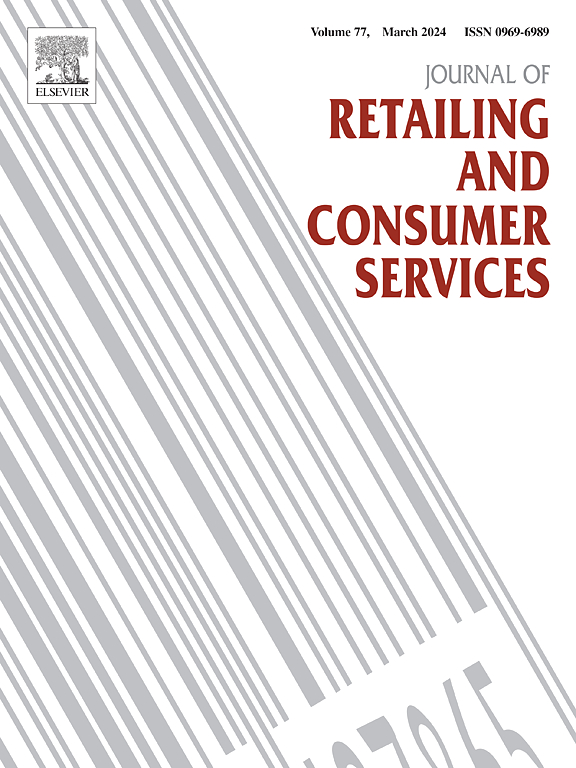取得适当的平衡:为管理客户在线退货倾向和满意度定制宽松的退货政策
IF 11
1区 管理学
Q1 BUSINESS
Journal of Retailing and Consumer Services
Pub Date : 2025-05-08
DOI:10.1016/j.jretconser.2025.104315
引用次数: 0
摘要
电子商务零售商通常采取慷慨的退货政策,这不仅是保护顾客购买的保证,而且有助于保持顾客的满意度。然而,这种策略可能会适得其反,因为它会鼓励冲动的购买行为,导致产品退货激增。这就造成了所谓的产品退货政策宽松困境。为了解决这一问题,本文旨在实证地发现产品退货政策宽松度维度(时间、货币、努力、范围和交换)与两个输出变量——客户退货倾向和满意度之间的关系。我们开发了一种混合方法,结合了基于机器学习的数据提取和逻辑回归,使用了包含沃尔玛退货政策和评论的大型经验数据集。结果表明,宽宏大量的三个维度——金钱、努力和范围驱动着顾客的回报倾向和满意度。时间只驱动满足,而不是倾向,交换是相反的。我们的研究结果表明,消费者在时间、精力和交换方面都能接受退货政策的合理限制。然而,过于宽松的退货政策条款可能无法充分解决退货政策困境。此外,对于有退货倾向的客户来说,如果他们认为最初的购买成本很高,部分退款/补货费是可以接受的。允许某些危险/大件产品在有条件的情况下退货也可能被视为潜在退货者的慷慨条款。总的来说,电子零售商应该通过在五个维度上结合不同程度的宽容来显示灵活性,以平衡回报满意度和意图。本研究为电子零售商设计合适的定制退货政策提供了指导。本文章由计算机程序翻译,如有差异,请以英文原文为准。
Striking the right balance: Customising return policy leniency for managing customer online return proclivity and satisfaction
E-commerce retailers (e-tailers) commonly adopt generous return policies which not only act as a guarantee to protect the customer's purchase but also help in maintaining their satisfaction. However, this strategy can backfire by encouraging impulsive purchasing behaviour and resulting in a surge of product returns. This creates what is termed the product return policy leniency dilemma. To address that, this paper aims to empirically discover the relationships between product return policy leniency dimensions (time, monetary, effort, scope, and exchange) and two output variables – customer return proclivity and satisfaction. We develop a hybrid method combining machine learning-based data extraction and logistic regression, using a large empirical dataset comprising return policies and reviews from Walmart. The results show that three leniency dimensions – monetary, effort and scope drive customer return proclivity and satisfaction. Time only drives the satisfaction but not proclivity while exchange is in reverse. Our findings imply that customers are amenable to reasonable restrictions in return policies regarding time, effort, and exchange. However, overly lenient return policy terms may fail to adequately address the return policy dilemma. Additionally, partial refund/restocking fees are acceptable for customers with return proclivity if they perceive the initial purchasing cost heavily. Allowing some hazardous/bulky products to be returned under condition may also be seen as a generous term from prospective returners. Overall, e-tailers should display flexibility by incorporating different levels of leniency across five dimensions to balance return satisfaction and intention. This study provides e-retailers a guidance to design an appropriate bespoke return policy.
求助全文
通过发布文献求助,成功后即可免费获取论文全文。
去求助
来源期刊
CiteScore
20.40
自引率
14.40%
发文量
340
审稿时长
20 days
期刊介绍:
The Journal of Retailing and Consumer Services is a prominent publication that serves as a platform for international and interdisciplinary research and discussions in the constantly evolving fields of retailing and services studies. With a specific emphasis on consumer behavior and policy and managerial decisions, the journal aims to foster contributions from academics encompassing diverse disciplines. The primary areas covered by the journal are:
Retailing and the sale of goods
The provision of consumer services, including transportation, tourism, and leisure.

 求助内容:
求助内容: 应助结果提醒方式:
应助结果提醒方式:


